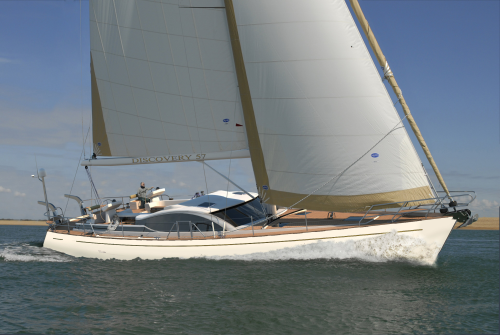

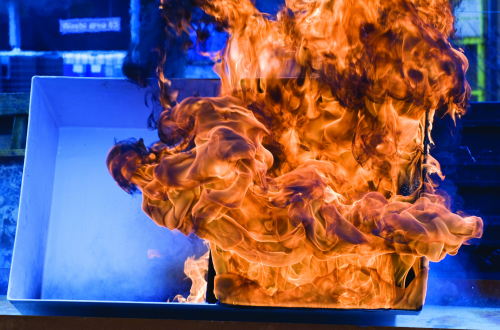
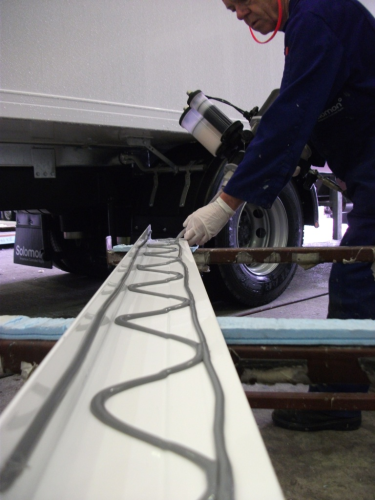
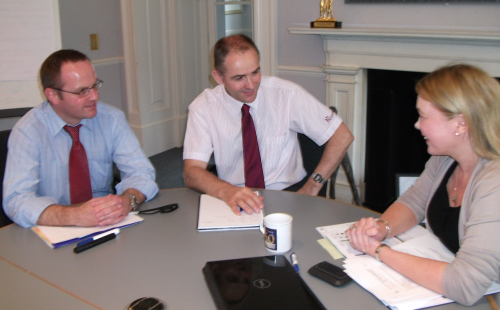
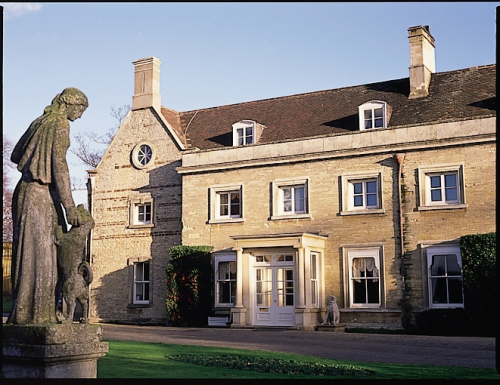
Scott Bader is an unusual company in that its it is employee-owned. In today’s extremely competitive and changeable composites market, Scott Bader believes this corporate structure gives it a competitive advantage, allowing it to take a long term view and build long term partnerships with customers.
Scott Bader believes another of its strengths is its history of innovation.
“We were one of the first producers of unsaturated polyester resins in the early 1950s,” Malcolm Forsyth notes. “We were the first to produce a product you could actually make a boat hull from in 1954. We were also one of the pioneers of gel-coat technology, and we introduced a number of adaptations and new products in terms of urethane acrylate technology. Urethane acrylate adhesives have been used in some of the biggest naval structures in the world and are used by many of the large leisure powerboat manufacturers.”
Globalisation
For the first 40 years of its existence Scott Bader was a UK company. It started to expand internationally in the mid-1960s, setting up a joint venture in France, which it eventually took over. In the 1990s this international expansion intensified and Scott Bader acquired a number of trading companies in Europe, giving it sales offices in Scandinavia, the Czech Republic (a route into Eastern Europe), Spain (one of the biggest polyester resin markets in Europe at the time), and the Middle East. This plant has been one of the company’s biggest profit generators for the last 10-15 years, Forsyth notes, with Scott Bader establishing a leadership position in resins for pipes in the Middle East.
|
Established: 1921 Employees: 600 Headquarters: Wollaston, UK Business focus: Composites – primarily the supply of unsaturated polyester resins, but also gel-coats and adhesives; and Speciality Polymers – production of solvent and water based emulsions and alkyd resins for the coatings, textiles & other markets. Turnover: €220 million (80% of this relating to composites) Manufacturing locations: UK; France; Croatia; UAE; South Africa |
Scott Bader also has a company in South Africa and has set up trading offices in America and China. The company is continuing on a globalisation path.
“In the coming years we are looking to significantly strengthen and grow our presence in many of the markets where today we’re relatively small,” reports Forsyth. “Latin America is where we are currently focusing. We have a long term licensee relationship there and we’re in dialogue as to how that can be developed as Brazil has become a major composites market and will continue to grow faster than most other world regions.”
Forsyth says Scott Bader is already working on partnerships that will facilitate its globalisation plans and he expects to be announcing a number of strategic alliances in the coming months. He says the company is looking to work with “significant players” in all of the major world markets.
Market drivers
The need for further globalisation was one of the key findings of a strategic review of its business Scott Bader recently conducted. The review was originally started in 2007/8 but it was put on hold while the company focussed on navigating through the financial crisis of 2008-2010. It was picked up again in 2010 and concluded last year. Three clear themes emerged.
First of all, the company found it was insufficiently profitable for secure long term sustainability and prosperity.
“We had remained profitable through the recession but not at a level that we would say allows us to confidently anticipate the investment spend that we’ll need to make, and that will give us the level of profitability that can safely absorb the potential variations that may come,” explains Forsyth.
Secondly, as a UK headquartered company a significant proportion of Scott Bader’s sales are in North West Europe, which is not a growth area.
“The reality of the world today is that for the next ten years, or possibly longer, North West Europe will almost certainly have the lowest growth rate of any market, both overall and in composite terms,” Forsyth notes. “The areas with the highest growth will be markets such as China and its surrounding Asian countries, and Latin America, countries where today our presence is at best modest, and in some cases almost zero. We need to align ourselves to where growth is going to happen while continuing to focus on supplying both core and new technology in Europe.”
The third theme which emerged from the review involved maximising the return from its innovation activities.
“We invest heavily in R&D and need to ensure we achieve good impact from new products," Forsyth says. “There are a number of new technologies that have been worked upon in R&D over recent years and we need to make sure we are organised in the right way to maximise benefit from new product introductions.”
The review also highlighted technology trends within the composites industry that the company needed to adapt to. In particular, the emergence of carbon fibre from being a niche, high tech, high priced material to becoming much more mainstream and present in all markets.
Forsyth summarises the challenges the review had brought into focus: “Our existing business models had been quite regional and had served us well, but we now needed some new models to adapt to the changing market circumstances which were presenting themselves. We clearly needed to invest more on a global basis to strengthen our sales and corporate presence in growing markets. We needed to ensure that our R&D investment paid better returns, and we needed to make sure the products we develop are the right ones for the market and will generate good returns. And we needed to do this at a time when key markets are still in the doldrums.”
Acting on these findings, Scott Bader is now implementing a new strategy to take it through to 2020.
“The key change for us going forward is a much stronger focus on globalising some key product technologies that we believe we’ve got, and the organisational change to deliver that,” reports Forsyth. “And that’s led to the creation of what we’re calling our Adhesives and Advanced Composites business unit. This will be a team of people whose sole focus is profit growth from key technologies which we can sell on a global basis through strengthened global sales channels, whether that’s our own people, joint ventures or other routes to the market. We’ve got to be stronger in those growing markets and we’ve got to be able to bring products that build strong positions.”
This is the business Forsyth is now leading, having handed over the reins of the European composites business to one of his fellow directors.
“Our European business remains critically important to us,” he confirms, “but it will be run with a rigorous cost management approach to maximise the profit and cash outcomes from it. That just reflects the fact it’s a relatively commodity business and we have to be quite lean and mean about the way we run it. We need it to continue to generate good profit and cash streams for us which will allow us to reinvest to strengthen and accelerate our growth in other parts of the world.”
Strategic focus
Currently there are eight people in the new Adhesives & Advanced Composites team, largely based in Wollaston. Their role is to guide and support Scott Bader’s sales teams, partners and distributors around the world who are actually selling the products. This team is focused on three product technologies which Scott Bader believes have a technology advantage.
Adhesives is one of these.
“We see adhesives as a major strategic focus for us, with strong growth potential across the world, partly because markets are turning to structural adhesives as a technical way of improving productivity, improving product quality, and reducing cost. “
Another important technology is gel-coats, where Scott Bader has 50 years of experience and a strong technology base.
“We’ve got a wide range of what we consider to be technically leading products for specific gel-coat applications. Whether that be ultra-high-weathering gel-coats to give the best possible colour and gloss retention on structures such as buildings or boats, or whether it be more sophisticated fire retardant technology. Some of our intumescent gel-coats actually prevent the spread of flame.”
Scott Bader also has a partnership with Microban for an anti-bacterial gel-coat for hospitals and areas where the control of infection is vitally important. It also has a range of polyester gel-coats for bonding to epoxy resins, which is traditionally a big challenge. However, the company has developed a polyester based gel-coat which gives good adhesion to epoxy systems and yet retains the benefits of polyester gel-coat in terms of colour retention and other properties. It is also working on new gel-coats with substantially lower levels of styrene, which are currently in trials with customers, and this is going to be a major thrust going forward, Forsyth confirms.
“From a regulatory point of view it’s likely there’s going to be some tightening of allowable styrene emissions in the workplace. We are coming forward with products which allow our customers to fully comply yet retain a lot of the virtues and benefits they get from existing polyester gel-coats.”
Crystic Permabright colour-stable gel-coatScott Bader believes its Crystic Permabright® gel-coat is a technology leader. It is based on a D-Iso/NPG polyester technology developed by Scott Bader and designed to combat colour change. White and cream polyester gel-coats turn yellow when exposed to UV light. Following 12-month Florida exposure testing, a white Crystic Permabright gel-coat demonstrated a Delta E value of 1-1.5. Delta E is a measure of how much the colour has changed compared to the original unexposed sample. Since a Delta E value of 1 is the smallest colour difference the human eye can detect the colour change of Crystic Permabright is very difficult to see. Tests have shown that Crystic Permabright has two times better colour stability than the ‘next best in class’ iso/NPG gel-coat, and four times better colour stability than a standard isophthalic gel-coat. Crystic Permabright is available in white, off-white and cream shades, has low styrene content, and its handling is similar to an iso/NPG based gel-coat. It can also be used below the waterline in boat applications since its water uptake is very low and it has high resistance to osmotic blistering when used as part of a marine grade system. As well as marine applications, Crystic Permabright is finding uses in the building and transportation markets. |
Crestapol high performance resinsThe Crestapol® range of high performance urethane methacrylate resins draw on over 25 years of urethane methacrylate resin development experience gained from Scott Bader’s Crestomer structural adhesives. Suitable for closed moulding and pultrusion processes, Crestapol has delivered 20% increases in production plus significant reductions in scrap rates. Crestapol 1250LV was developed specifically for producing high performance carbon fibre reinforced (CFRP) and glass fibre (GRP) parts by vacuum infusion, resin transfer moulding (RTM) or other closed mould processes. It can be processed at room temperatures, needing only short periods of moderate post curing to achieve good mechanical and high temperature performance. Crestapol 1250LV provides a cost effective alternative to epoxy infusion resin systems. It is as easy to use as a typical unsaturated polyester resin, but when reinforced with carbon fibre it has a mechanical performance similar to, or exceeding, an equivalent carbon fibre epoxy resin laminate. Crestapol 1250LV carbon fibre laminates can also withstand extreme environmental conditions better than typical epoxy systems. Under controlled test conditions, Crestapol 1250LV has been proven to retain a very high percentage of its mechanical properties even after prolonged exposure to salt water and severe hot-cold thermal cycling. |
Crestabond primer-less adhesivesThe Crestabond® range of 1:1 and 10:1 methacrylate structural adhesives are able to bond a wide variety of dissimilar substrates (including GRP, stainless steel, aluminium, and plastics such as ABS and acrylic) without the need to use primers to improve bond performance and with minimal surface preparation. This enhances production efficiency and reduces consumable costs. The adhesives also demonstrate excellent fatigue and impact resistance and good gap filling capability. A range of working and fixture times means customers can optimise their production cycles to reduce manufacturing costs. The adhesives can be applied using a manual or pneumatic gun. |
Forsyth notes that Scott Bader will be working with partners to develop its gel-coat business in regions where it does not have its own manufacturing facilities.
The third technology focus area is Crestapol urethane acrylate based resins. These enable customers to take polyester resin performance to a much higher level in terms of mechanical properties. For example, Crestapol 1250 was specifically designed for use with carbon fibre. There are also Crestapol products which are used for very fast cycle closed moulding and others that give very high fire and smoke performance when used in combination with different fillers.
“Often when you heavily load a resin system it becomes very difficult to use – it doesn’t flow,” explains Forsyth. “We can load Crestopol resins with very high levels of filler and still get a system which you can put through an RTM machine. You can get the very high fire and smoke performance the customer is looking for but do it in a way that is productive in terms of process, in terms of cost, and in terms of quality in the final part.”
Scott Bader is also restating its investment in R&D, an area which many of its competitors are not investing a great deal in, says Forsyth.
“We’re going to be increasing our spend on R&D, which is the life blood of the future of our company,” Forsyth confirms. “We must continue to bring to market solutions which make a genuine improvement. We expect to be bringing a steady flow of significant new products every year for the next few years.”
“We are re-emphasising that we are a technology company,” concludes Forsyth. “We will be successful by having the best technology, the best products, with the best service backup. We’re not going to be the biggest provider, but we want to differentiate ourselves by providing technology and support and service which makes us a supplier of choice. We’re got a technology mindset and we invest in R&D. I think that’s something that will increasingly mark us out from our competitors.”
Forsyth believes the other important aspect of its new strategy is Scott Bader’s continued commitment to the composites market.
“I think it is legitimate to question the ongoing or long-term commitment of some of the players. What we can state categorically is that we are committed to the composites market for the long term. It is the core of our company business. We’re not going anywhere and we want to be a bigger, stronger, more global player.”
“We believe it’s a message which should be positively engaged with in the marketplace,” he concludes. “Customers want to hear that suppliers have got a clear strategy, clear investment aim and are positive about delivering it.” ♦
Further information
Malcolm Forsyth, Scott Bader; e-mail: Malcolm_Forsyth@scottbader.com; www.scottbader.com.
|
Scott Bader was founded in 1921 by Ernest Bader, a Quaker and a chemist, and his wife Dora Scott. They set up a trading company in London, importing novel materials. Over the years Bader built up a healthy business but in 1940, as London came under attack during World War II, he decided to move the company somewhere safer. He chose a rather rundown country house in a 44 acre estate in the village of Wollaston in Northamptonshire, and during the summer of 1940 Bader moved his family, his company and a significant number of his employees there. “And that is how we come to be here – a global chemical company headquartered in a 300 year old country house in the middle of a Northamptonshire village,” says Forsyth. “This is a context which you could not imagine happening today, for all sorts of reasons, and I guess that reinforces the fact that we are not a conventional company.” The next major milestone in Scott Bader’s history came in 1951 as Ernest Bader began to think about succession. “He had very strong views about how he wanted his company to be; he wanted his employees to have a share in the company and have a say in the long term health of the business,” Forsyth explains. “In what was, at the time, a very radical step, both he and his family effectively gave away all their shares in the company, put them in a charitable trust, and made the employees the trustees.“ “As employees we are trustees of the shares, we do not own them,” he continues. “Our charge is to look after them and hand them on to the next generation of workers in better health than we inherited them from the previous generation.” As a Common Trusteeship Company with no external shareholders, Scott Bader’s source of income is its own profitability and bank loans. This means the company cannot bring in large quantities of capital, but does prevent it from becoming overly burdened with debt. Major strategic plans are shared internally through the Employee Members’ Assembly, which gives personnel the opportunity to voice their opinions. The other major implication of this structure of self-governance is that the company cannot be bought or sold. “The great virtue of this is that as a company is does allow us to take a long term perspective,” Forsyth points out. “And it allows us as well to position ourselves with customers and suppliers and other stakeholders as long term partners and players. So customers can know for sure that, unless we go bankrupt, Scott Bader will be here, called Scott Bader, headquartered in Wollaston, in ten years time.“ Forsyth believes this ability to build long term partnerships is one of the company’s major strengths. “We’re not just looking to be a supplier for the next two months, we want to be a supplier for the next ten years,” notes Forsyth. “Many of our customers have been our customers for decades. This doesn’t mean we don’t have tough negotiations on prices, but it means we’re operating in a broader context of wanting to work together for each other’s benefit for the long term.” |
This feature was published in the July/August 2012 issue of Reinforced Plastics magazine.
The digital edition of Reinforced Plastics is distributed free of charge to readers who meet our qualifying criteria. You can apply to receive your free copy by completing the registration form.




